
views
Working up the Ranks

Join a Scout troop. Join a troop that you like and that fits with your personality. It’s a good idea to choose a local troop. Boys and girls can join Cub Scouts as early as the first grade. Once a boy or girl is older than 10, or has completed the fifth grade, he or she can join Scouts. You can join Venturing for ages 14 through 20. Eagle Scout requirements must be completed before the Scout’s 18th birthday, so it’s best to join the Scouts young, when you’ll have plenty of time to complete all the requirements.
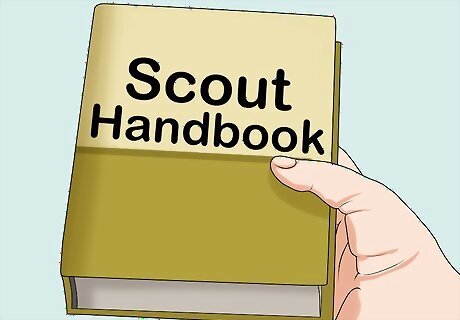
Familiarize yourself with the Scout Handbook. The Scout Handbook is the official handbook of the Scouts derived from Robert Baden-Powell’s original Scouting for Boys. It contains all the requirements to earn your ranks. The handbook has great tips on camping. Get Scoutbook and go digital! It’s an easy web application to track progress that’s fun for Scouts and easy for unit leaders to track.
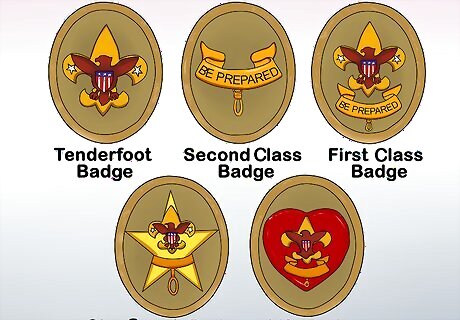
Earn the ranks that come before Eagle Scout. To become eligible for the rank of Eagle Scout, you must first earn Scout, Tenderfoot, Second Class, First Class, Star, and Life Ranks. These ranks require accomplishments in camping, cooking, navigation, nature, aquatics, first aid, fitness, leadership, safety, citizenship, and Scout spirit. These ranks take time to earn and cannot be done in a rush. Make sure you join Scouts with enough time to accomplish these ranks. Part of advancing in the ranks is accomplished by earning merit badges, which signify a Scout’s knowledge and skills in a particular area. By the time a Scout completes Life Rank, they’ll have 11 merit badges that they’ve earned.
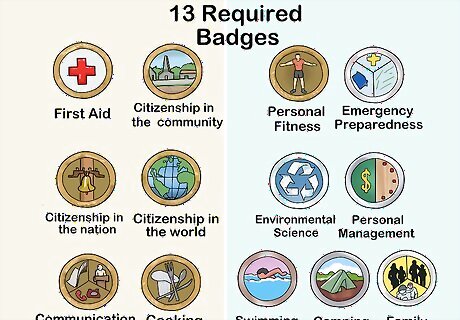
Complete merit badges, keeping in mind requirements for Eagle Scout. As you move up the ranks completing your merit badges, you should think about the merit badges you’ll have to complete for the Eagle Scout rank. While you only have to get an additional 10 merit badges for Eagle Rank, 13 badges of the cumulative 21 badges must be in certain areas. So you should keep those in mind as you work towards this goal. It’s best to try to get the more difficult merit badges done before moving on to your Eagle Scout requirements, since you’ll want to devote your time to your Eagle Scout service project.
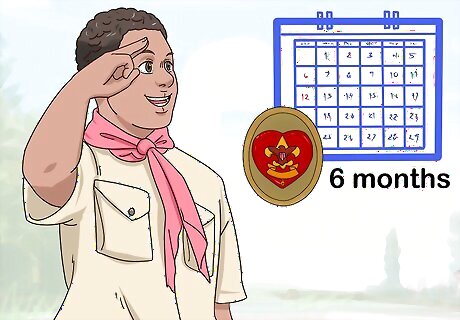
Be an active Life Scout for at least six months. To become eligible for the Eagle Scout rank, you must first have been an active Scout at the Life Rank for at least six months. Make sure you’ve got these six months to spare before your 18th birthday!
Fulfilling Eagle Scout Requirements

Get the required 10 additional merit badges. To achieve Eagle Scout Rank, you must complete an additional 10 merit badges, bringing your cumulative number of badges up to 21. 13 of these total 21 badges must be from specific categories. The 13 required merit badges must include the following: First Aid, Citizenship in the Community, Citizenship in the Nation, Citizenship in the World, Communication, Cooking, Personal Fitness, Emergency Preparedness or Lifesaving, Environmental Science or Sustainability, Personal Management, Swimming or Hiking or Cycling, Camping, and Family Life.
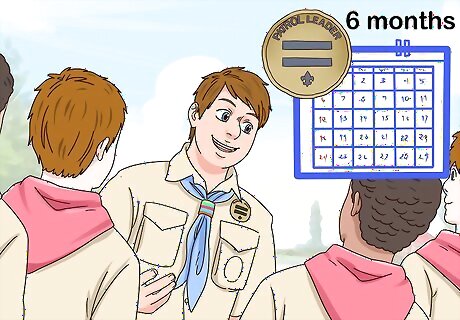
Serve your troop for six months as a leader. In order to meet the Eagle Scout requirements, you’ll need to serve your troop in a leadership capacity for six months. You can serve your own troop, the Varsity Scout team, the Venturing crew or Sea Scout ship, or serve as a Lone Scout. For example, you can serve your troop by acting as a patrol leader, troop guide, chaplain aid, or junior assistant Scoutmaster. You could be captain or squad leader for your Varsity Scout team. Be a boatswain, storekeeper, or quartermaster for Venturing crew or Sea Scout ship. A Lone Scout serves in a leadership capacity outside of the Scouts in a school, religious, or community setting.

Participate in a Scoutmaster conference. The aspiring Eagle Scout must participate in a Scoutmaster conference, which is a conference between the Scoutmaster and the Scout. Topics of discussion include your ambitions, future goals, and how you are doing in the troop. This is a useful time to talk out the final hurdles the Scout will undergo to get their Eagle Scout Rank- the Eagle Scout service project and the Board of Review.

Think about your service project. To become an Eagle Scout you’ll need to plan and execute a service project that benefits a religious institution, school, or your community. The project must be approved by your unit leader and the institution it’s benefitting. If you’re stumped on project ideas, consult community, Scout, or religious leaders to see what projects they may need help with. Most Eagle Scout service projects are construction based. For example, many Scouts build bridges, decks, or playgrounds for an institution in need. Other more unique project ideas include hosting a free football camp for low income kids or collecting shoes to send to earthquake victims.

Submit the proposal form for your project. You need to submit your project proposal for your Eagle Scout service project; this is the Eagle Scout Service Project Workbook. The proposal includes the scope of your project and its timeline. The project is evaluated based on the following: feasibility, safety issues, the steps of the plan for execution, and whether the project is one that will give the Scout a positive experience.

Complete the service project. After your project is approved, you will complete your Eagle Scout service project by fundraising and soliciting volunteers along the way to help you. To successfully complete your project, rely on the schedule you created for your project approval. Take advantage of the internet and crowdfund to raise money for your project. One of the goals of the Eagle Scout service project is to demonstrate your leadership, so refrain from doing the entire project yourself. Enlist and delegate tasks to volunteers to demonstrate your leadership abilities. Recruit volunteers from school, church, or your neighborhood.

Participate in the Board of Review. Your final step is to prepare for, attend, and take part in the special Eagle Scout Board of Review. This board is made up of your troop leaders and a representative from council. You'll need to prepare documents, including your Eagle Scout Application, a statement of your ambitions and life purpose, a list of all positions dealing with leadership, and a statement of any honors or awards received. Part of the Eagle Scout Application includes six references who can speak to the Scout’s character. These can include parents, relatives, Scout leaders, or other Scouts and friends. However, the references must be be 21 or older.

Go to your Eagle Scout ceremony. After successful completion of all the requirements for Eagle Scout Rank, go to the Eagle Court of Honor Ceremony, where you can proudly accept that handshake and smile from your Scoutmaster as they read your name aloud.




















Comments
0 comment